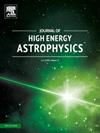Insights into f(Q) gravity: Modeling through deceleration parameter
IF 10.2
4区 物理与天体物理
Q1 ASTRONOMY & ASTROPHYSICS
引用次数: 0
Abstract
In this paper, we have reconstructed gravity cosmological models with the novel forms of the deceleration parameter. The parameters are constrained by incorporating the cosmological datasets from Hubble parameter, Type Ia Supernovae and Baryon Acoustic Oscillations. We have examined two parametrizations of the deceleration parameter and fit them into the models through Monte Carlo Markov Chain (MCMC) analysis, one with the power-law function and the other one with the logarithmic function. The Power-law model exhibits strong agreement with higher values, aligning well with recent measurements, whereas the logarithmic model achieves lower matter density constraints. Both the models successfully recover observationally consistent estimates for the Hubble constant and matter density , though with varying degrees of precision and alignment with the ΛCDM as a limit. These two models are used to reconstruct the function for each case, yielding analytical expressions that closely align with the numerical solutions. Statistical comparisons using Akaike Information Criterion (AIC) and Bayesian Information Criterion (BIC) reveal a competitive performance with the ΛCDM model and positioning these models as promising alternatives to explain late time cosmic phenomena.
求助全文
约1分钟内获得全文
求助全文
来源期刊

Journal of High Energy Astrophysics
Earth and Planetary Sciences-Space and Planetary Science
CiteScore
9.70
自引率
5.30%
发文量
38
审稿时长
65 days
期刊介绍:
The journal welcomes manuscripts on theoretical models, simulations, and observations of highly energetic astrophysical objects both in our Galaxy and beyond. Among those, black holes at all scales, neutron stars, pulsars and their nebula, binaries, novae and supernovae, their remnants, active galaxies, and clusters are just a few examples. The journal will consider research across the whole electromagnetic spectrum, as well as research using various messengers, such as gravitational waves or neutrinos. Effects of high-energy phenomena on cosmology and star-formation, results from dedicated surveys expanding the knowledge of extreme environments, and astrophysical implications of dark matter are also welcomed topics.
 求助内容:
求助内容: 应助结果提醒方式:
应助结果提醒方式:


